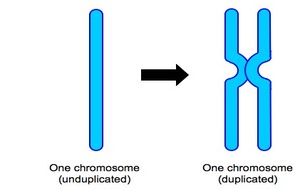2.5.1 Outline the stages in the cell cycle, including interphase (G1, S, G2), mitosis and cytokinesis
- The cell cycle is an ordered set of events that culminates in cell growth and division into two daughter cells
- It can roughly be divided into two main stages:
Interphase
- The stage in the development of the cell between two successive M phases
- This phase of the cell cycle is a continuum of 3 distinct stages (G1, S, G2), whereby the cell grows and matures (G1), copies its DNA (S) and prepares for division (G2)
- Sometimes cells will leave the cell cycle and enter into a quiescent state (G0), whereby it becomes amitotic and no longer divides
M phase
- The periods of nuclear division (mitosis) and cytoplasmic division (cytokinesis)
The Cell Cycle M Phase

2.5.2 State that tumours (cancers) are the result of uncontrolled cell division and that these can occur in any organ or tissue
- The cell cycle is controlled by a complex chemical control system that responds to signals both inside and outside of the cell
- Tumor suppressor genes produce proteins which inhibit cell division, while proto-oncogenes produce proteins that promote growth and division
- Mutations to these genes result in uncontrolled cell division, resulting in the formation of a tumour
- Tumours can grow in size which causes damage local tissue; they may also spread to other parts of the body (malignant tumours)
- Diseases caused by the growth of tumours are collectively known as cancers
![]() Cancer in Tasmanian Devils
Cancer in Tasmanian Devils
2.5.3 State that interphase is an active period in the life of a cell when many metabolic reactions occur, including protein synthesis, DNA replication and an increase in the number of mitochondria and chloroplasts
Interphase is an active period in the life of a cell - many events need to occur before a cell can successfully undergo division:
- Protein synthesis: The cell needs to synthesise key proteins and enzymes to enable it to grow, copy its contents and then divide
- ATP production: The cell will need to generate sufficient quantities of ATP in order to successfully divide
- Increase number of organelles: The cell needs to ensure both daughter cells will have the necessary numbers of organelles needed to survive
- DNA replication: The genetic material must be faithfully duplicated before division (this occurs during the S phase)
As none of these processes can occur during the M phase, interphase contains growth checkpoints to ensure division is viable
- G1: A checkpoint stage before DNA replication during which the cell grows, duplicates organelles, synthesises proteins and produces ATP
- S: The stage during which DNA is replicated
- G2: A checkpoint stage before division during which the copied DNA is checked for fidelity (mutations) and final metabolic reactions occur
2.5.4 Describe the events that occur in the four phases of mitosis

Prophase
- DNA supercoils, causing chromosomes to condense and become visible under a light microscope
- As DNA was replicated during interphase, the chromosomes are each comprised of two genetically identical sister chromatids joined at a centromere
- The centrosomes move to opposite poles of the cell and spindle fibres begin to form between them (in animals, each centrosome contains 2 centrioles)
- The nuclear membrane is broken down and disappears
Metaphase
- Spindle fibres from the two centrosomes attach to the centromere of each chromosome
- Contraction of the microtubule spindle fibres cause the chromosomes to line up separately along the centre of the cell (equatorial plane)
Anaphase
- Continued contraction of the spindle fibres cause the two sister chromatids to separate and move to the opposite poles of the cell
- Once the two chromatids in a single chromosome separate, each constitutes a chromosome in its own right
Telophase
- Once the two sets of identical chromosomes arrive at the poles, the spindle fibres dissolve and a new nuclear membrane reforms around each set of chromosomes
- The chromosomes decondense and are no longer visible under a light microscope
- The division of the cell into two daughter cells (cytokinesis) occurs concurrently with telophase
2.5.5 Explain how mitosis produces two genetically identical nuclei

- During interphase (the S phase) the DNA was replicated to produce two copies of genetic material
- These two identical DNA molecules are identified as sister chromatids and are held together by a single centromere
- During the events of mitosis (as described in 2.5.4), the sister chromatids are separated and drawn to opposite poles of the cell
- When the cell divides (cytokinesis), the two resulting nuclei will each contain one of each chromatid pair and thus be genetically identical
2.5.6 State that growth, embryonic development, tissue repair and asexual reproduction involve mitosis
Growth: Multicellular organisms increase their size by increasing their number of cells through mitosis
Asexual reproduction: Certain eukaryotic organisms may reproduce asexually by mitosis (e.g. vegetative reproduction)
Tissue Repair: Damaged tissue can recover by replacing dead or damaged cells
Embryonic development: A fertilised egg (zygote) will undergo mitosis and differentiation in order to develop into an embryo